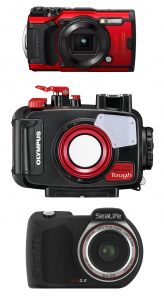 My “Methods” are pretty informal, natural history types of observations. My “equipment” consists of two underwater cameras, one with GPS, the other not. Currently these are an Olympus TG6 (with GPS) + PT059 Underwater Housing; and a Sealife Micro 3.0 . The TG6 is “waterproof” but I always put in it the Underwater Housing, a kind double jeopardy insurance.
My “Methods” are pretty informal, natural history types of observations. My “equipment” consists of two underwater cameras, one with GPS, the other not. Currently these are an Olympus TG6 (with GPS) + PT059 Underwater Housing; and a Sealife Micro 3.0 . The TG6 is “waterproof” but I always put in it the Underwater Housing, a kind double jeopardy insurance.
The SeaLife Micro has a 100 degrees lens (relatively wide-angle) and must be at least 15 inches from the subject. The benefits of this camera are its incredible robustness//easy to maintain, compact size, high storage capacity (64 HB) and long battery life (3 hours plus). I purchased it mainly as a backup for the TG6 which produces better quality GPS-tagged images, close-ups etc. As it turned out, in early 2024, the TG6 went on the fritz, so it was a good strategy!
In general I find that the photos as delivered on these cameras can benefit from a few adjustments. I use either a 2008 version of Photoshop, that on an old desktop computer; or Photoshop Elements 2023 (one time purchase//not subscription) on my laptop. I routinely process sets of photos using the Process Multiple Files option in Photoshop Elements, choosing one of more of Quick Fix Auto levels, Auto Contrast, Auto Color/Sharpen; that process reduces file size by 50-80% with essentially no loss and usually with some improvement of quality.
I use a depth gauge to measure depths on occasion. I use low resolution videos to record comments, numbers etc.
So the typical output is a set of photos in sequence with the locations shown on Google Maps. I like to post them in Google Photo albums, although it’s clunky in regard to uploading, sorting etc. But for the viewer, I think its’ an effective way of presenting ‘the data’. I also create Projects on various themes on iNaturalist.
My initial reason for coming to Barbados in 2015 (and to Carriacou in 2016) was to conduct formal, scientific surveys of seagrass beds, repeating sets of observations I conducted in 1969 and again in 1994. There are several papers coming out of that process, one published, one in press, and the third in preparation. I will make use of some of photos from those studies on this website/iNaturalist.
‘Have to say, I enjoy the ‘Naturalist option’ much more that the formal scientific processes – at least at this stage of life. Both have their place and time I guess.
